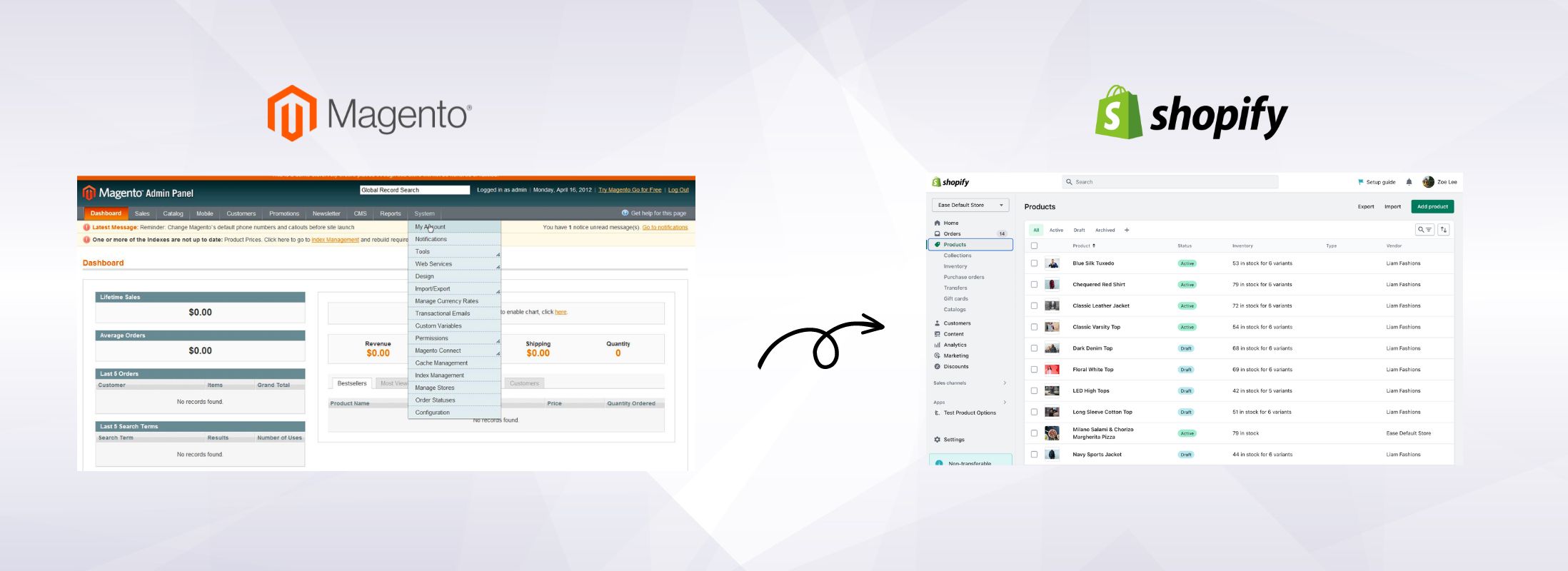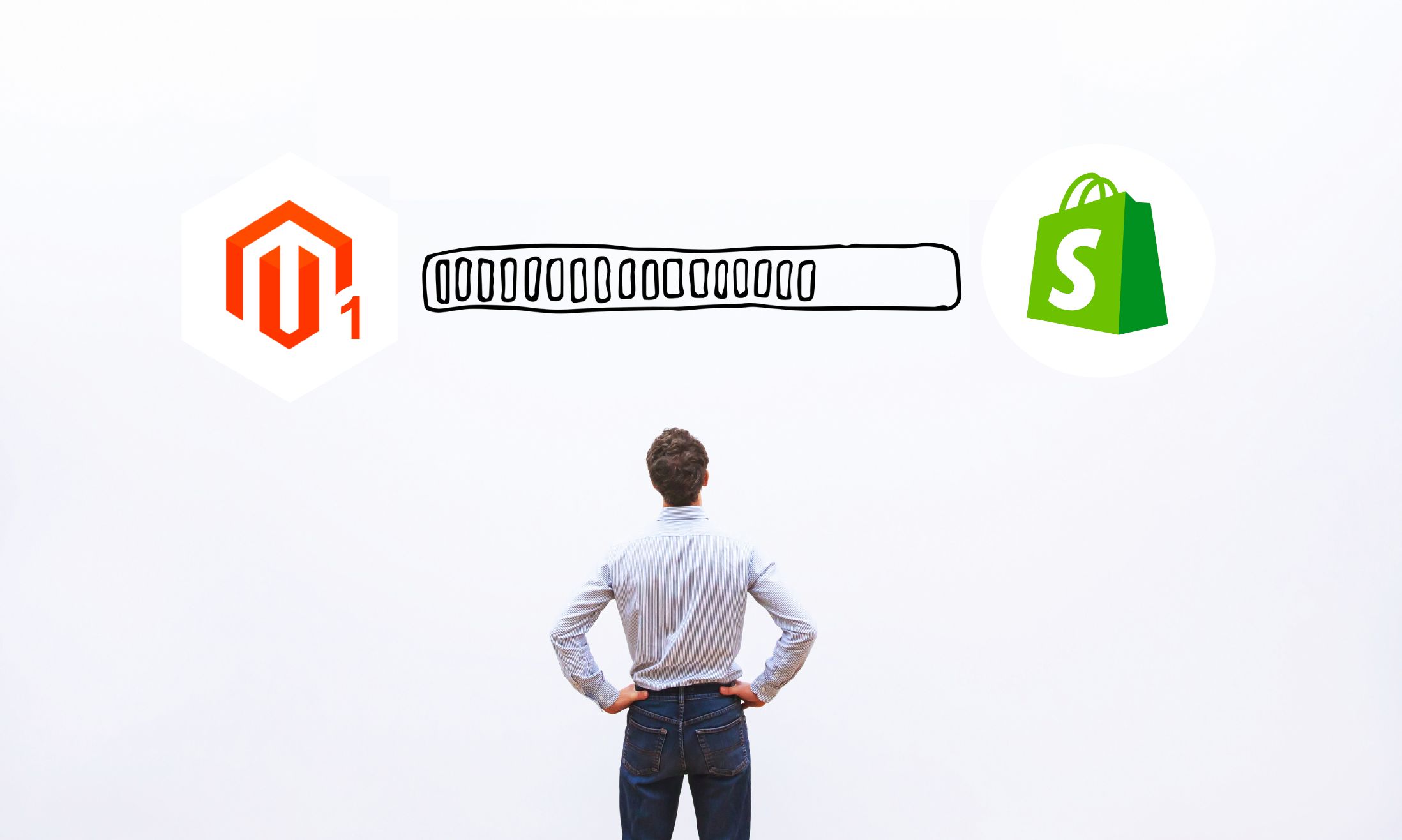When it comes to e-commerce platforms, Magento 1 and Shopify have been popular choices for online businesses. Magento 1 is an open-source platform known for its robustness and flexibility, while Shopify is a hosted solution that offers simplicity and ease of use.
However, the need for Magento 1 to Shopify migration arises from several reasons. Firstly, Magento 1’s support officially ended in June 2020, leaving users vulnerable to security risks and without access to critical updates.
Additionally, Shopify offers numerous benefits, such as enhanced performance, better user experience, and simplified administration. Therefore, many businesses are opting for Magento 1 to Shopify migration to leverage these advantages.
However, a successful migration requires thorough planning and preparation. Migrating from one platform to another can be a daunting task, especially when it involves the transfer of sensitive data and crucial functionalities.
It involves understanding the differences between Magento 1 and Shopify, assessing current store functionalities, and making informed decisions regarding data migration, design, and integrations. But, with careful planning and execution, the migration process can be smooth and successful.
Magento 1 and Shopify: A Brief Comparison
Magento 1 offers advanced features and extensive customization options. It provides robust catalog management, flexible product attribute creation, and powerful SEO capabilities. However, its complexity and maintenance requirements can be overwhelming for some businesses.
Shopify, on the other hand, is renowned for its user-friendly interface and ease of use. It offers a wide range of professionally designed themes, simplified store management, and built-in marketing tools. Shopify’s focus on user experience makes it an attractive choice for many businesses.
Comparing Magento 1 and Shopify will help you understand the strengths and weaknesses of each platform. While Magento 1 allows extensive customization and scalability, it requires technical expertise and substantial development resources. Shopify, on the other hand, offers a streamlined experience with fewer customization options but unmatched simplicity and convenience.
The Advantages of Migrating to Shopify
Deciding to migrate from Magento to Shopify offers numerous advantages for merchants. This section delves into the benefits of this transition, addressing how the complexities of e-commerce can be simplified and optimized by harnessing the power of Shopify’s robust platform.
Simplified administration and user-friendly interface

Shopify’s intuitive dashboard and user-friendly interface simplify store management tasks. With easy-to-navigate menus, you can effortlessly update products, manage inventory, and fulfill orders. This simplicity empowers business owners to focus on growth rather than dealing with complex technicalities.
Improved website performance and speed
Shopify’s cloud-based infrastructure ensures high performance and fast page loading times. This directly impacts user experience, conversions, and search engine rankings. By migrating to Shopify, you can provide your customers with a smooth browsing experience and significantly reduce bounce rates.
Built-in security features and regular updates
With Shopify, you don’t have to worry about security vulnerabilities or regularly patching your system. Shopify’s team handles security updates and provides robust built-in security features. This ensures your store is protected from potential threats and provides peace of mind for you and your customers.
Extensive app and theme marketplace
Shopify App Store offers a vast selection of apps (over 8,000 options) that can enhance your store’s functionality. From marketing and SEO tools to advanced inventory management systems, you can find solutions that suit your business needs. The theme marketplace provides beautifully designed templates that allow you to customize the look and feel of your store.
Pre-Migration Preparation

Analyzing and Documenting Current Store Functionality and Design
Before initiating the migration process, conduct a comprehensive analysis of your Magento 1 store. Identify the core functionalities, extensions, and customizations currently in use. Documenting this information will help you plan the migration effectively.
Assessing Extensions, Customizations, and Integrations
Evaluate the extensions, customizations, and integrations present in your Magento 1 store. Determine which ones are essential for your business operations and customer experience. This assessment will help you decide whether to replicate the functionality on Shopify or explore alternative solutions available on the platform.
Inventory Management and Product Data Preparation
Take the time to review your product data and inventory management processes. Ensure that your product information, SKUs, pricing, and stock levels are accurate and up to date. This step is crucial to facilitate a smooth transition and prevent any data inconsistencies or errors during the migration.
Choosing the Right Solution for Migration
Decide on the approach you will take for the migration process. You have three main options:
- Do It Yourself: If you have the technical expertise and a good understanding of both Magento 1 and Shopify platforms, you can opt for a DIY approach. This involves exporting your data from Magento 1 and manually importing it into Shopify. While this option gives you full control over the process, it requires significant technical knowledge and can be time-consuming.
- Use Migration App: Another option is to leverage Magento to Shopify migration apps. These apps are designed to streamline the migration process by automating the data transfer and minimizing disruptions to your store’s functionality. However, you may still need to perform certain manual tasks and ensure compatibility with your specific setup.
- Hire a Migration Service Provider: If you prefer a more hands-off approach and want professional assistance, engaging a migration service provider is an excellent choice. These experts specialize in Magento 1 to Shopify migrations and can handle the entire process for you. They have the experience and knowledge to ensure a seamless transition, minimizing any potential risks or disruptions.
Setting a Realistic Budget for the Migration Process
Determine a budget for your migration project. Consider the costs associated with any required extensions, theme development, migration apps, or professional migration services. It’s essential to allocate sufficient resources to ensure a successful migration without compromising on quality or functionality.
Magento 1 To Shopify Migration Process
New Shopify store setup
Start by creating a new Shopify store. Sign up for an account and follow the step-by-step instructions provided by Shopify. This process includes selecting a domain name, configuring basic settings, and choosing a plan that aligns with your business requirements.
Theme selection or development
Select a Shopify theme that aligns with your brand identity and desired store design. Shopify offers a wide range of professionally designed themes that can be customized to suit your preferences. Alternatively, you can opt for custom theme development to create a unique and tailored store layout.
Product migration and data transfer
Export your product data from Magento and import it into Shopify. This includes product details, images, SKUs, pricing, and inventory information. Depending on your chosen migration method, you may need to follow specific instructions provided by migration apps or service providers.
Content migration
Migrate your content from Magento 1, including pages, blog posts, images, and any other relevant content. Ensure that all URLs are properly redirected to maintain SEO rankings and avoid broken links. Shopify provides tools and resources to assist you in this process.
Payment gateways and shipping methods configuration
Set up payment gateways and configure shipping methods in Shopify. Connect your preferred payment providers to offer seamless and secure checkout experiences for your customers. Configure shipping options based on your business requirements and customer preferences.
New Shopify app installation
Explore the Shopify app store to find and install apps that enhance your store’s functionality. Consider the apps you previously used on Magento 1 and look for suitable alternatives available on the Shopify platform. Install and configure these apps to seamlessly integrate them into your new store.
Other third-party software integrations
Rebuild any integrations with third-party software or services that were previously in place on Magento 1. This may include CRM systems, email marketing platforms, inventory management tools, or analytics platforms. Consult the respective providers or experts for guidance on integration processes.
URL redirection and SEO settings
Implement proper URL redirections to ensure that your existing Magento 1 URLs are redirected to the correct corresponding pages on your new Shopify store. This step is crucial to preserve your search engine rankings and prevent any broken links.
Shopify provides built-in tools and resources to assist you in setting up proper URL redirects. Additionally, configure SEO settings in Shopify to optimize your store’s visibility and search engine performance.
Post-Migration Tasks
Thoroughly testing the migrated store for functionality and design

After the migration process is complete, thoroughly test your Shopify store to ensure that all functionalities, including product listings, checkout process, and integrations, are working smoothly. Check for any discrepancies or errors and address them promptly. Test the store on different devices and browsers to ensure optimal user experience.
Training staff and users on the new platform
Provide training to your staff and users on how to effectively navigate and manage the new Shopify platform. Familiarize them with the store’s administration features, order management, and product updates. This will empower your team to efficiently operate the new system and leverage its capabilities.
Setting Up Google Tracking for Performance Analysis
Implement Google Analytics and other tracking tools to monitor your store’s performance, user behavior, and conversion rates. Set up relevant goals and tracking parameters to measure the success of your migration and identify areas for improvement. These insights will help you make data-driven decisions and optimize your store’s performance.
Tracking and analyzing website performance metrics
Continuously monitor and analyze website performance metrics, such as page load speed, bounce rates, and conversion rates. Identify any bottlenecks or areas where improvements can be made. Utilize Shopify’s built-in performance tools and consider implementing optimization techniques, such as image compression and caching, to enhance your store’s speed and user experience.
Optimizing page load speed and mobile responsiveness
Page load speed and mobile responsiveness are critical factors in providing a positive user experience. Optimize your store’s performance by minimizing image file sizes, leveraging caching mechanisms, and ensuring responsive design. This will enhance your store’s usability and encourage visitors to engage with your products and complete their purchases.
Monitoring customer feedback and resolving issues promptly
Encourage customers to provide feedback on their experience with the new Shopify store. Monitor customer reviews, inquiries, and complaints and address them promptly and professionally. Demonstrating exceptional customer service will build trust and loyalty among your customers, ensuring the success of your migration.
Magento 1 to Magento 2 Migration vs. Magento 1 to Shopify Migration
Many businesses today find themselves at a crossroads, wondering whether they should migrate from Magento 1 to Magento 2 or explore alternative platforms like Shopify. It’s a decision that requires careful consideration and a thorough understanding of the pros and cons associated with each migration process.
In this section, we will provide a quick comparison of the two options by outlining the advantages and disadvantages of migrating from Magento 1 to Magento 2 and migrating from Magento 1 to Shopify.
Related Post: Magento 2 To Shopify Migration: Unlocking Key Benefits
Magento 1 to 2 Migration
Pros:
- Continuity of the Magento ecosystem: If you have been using Magento 1 for a long time, you may be familiar with its ecosystem, and upgrading to Magento 2 can offer continuity in that regard.
- Enhanced design, performance and scalability: Magento 2 boasts an improved codebase, which means faster performance, better scalability, and enhanced design capabilities.
- Access to updated features and security patches: Magento 2 offers many updated features and security patches that may not be available on Magento 1.
- More user-friendly admin dashboard compared to Magento 1: Magento 2 has a more user-friendly admin dashboard than Magento 1, making it easier to manage your store.
Cons:
- Development of a new website based on Magento 2: Migrating from Magento 1 to Magento 2 requires building a new website from scratch, which can be a time-consuming and costly process.
- Unavailability of reusing Magento 1 theme and extensions: Magento 2 uses a different codebase than Magento 1, which means that themes and extensions from Magento 1 cannot be reused on Magento 2.
- Higher cost of extensions compared to Magento 1’s: Many of the extensions that were available for Magento 1 may not be available or are more expensive on Magento 2.
Magento 1 to Shopify Migration
Pros:
- Simplified administration and user-friendly interface: Shopify is known for its user-friendly interface and streamlined administration, making it easier to manage your store.
- Improved website performance and speed: Shopify is a cloud-based platform, which means that it is optimized for speed and performance.
- Built-in security features and regular updates: Shopify offers built-in security features and regular updates, reducing the risk of security breaches and ensuring your store is always up-to-date.
- Extensive app and theme marketplace: Shopify has an extensive app and theme marketplace, which offers a wide variety of options for customizing your store.
Cons:
- Development of a new website based on Shopify: As with Magento 2, migrating from Magento 1 to Shopify requires building a new website from scratch, which can be a time-consuming and costly process.
- Inability to reuse Magento 1 theme and extensions: Themes and extensions from Magento 1 cannot be reused on Shopify, which means you will need to find new apps for your Shopify store.
- Differences in app pricing models: Majority of Shopify apps follow a subscription-based model with monthly fees, while the majority of Magento extensions utilize a one-time fee structure.
- Limited customization options compared to Magento: While Shopify offers a wide variety of customization options, it is not as flexible as Magento, which can be a disadvantage for some businesses.
- Necessity to adapt business processes to Shopify’s ecosystem: Shopify has its own ecosystem, which means that you may need to adapt some of your business processes to fit within it.
Ultimately, the decision between Magento 2 and Shopify depends on your business needs. Consider both options carefully and choose what suits you best. Tigren offers migration services for both Magento 1 to Magento 2 and Magento to Shopify, as well as other eCommerce platforms. Partnering with us can help ensure a smooth transition.
If you require professional assistance with your Magento to Shopify migration, Tigren can provide the expertise and experience you need. With over 10 years of experience (since 2012) in e-commerce development, we understand the intricacies of both Magento and Shopify platforms.

Our team offers comprehensive migration services, ensuring a seamless transition while preserving your store’s functionality, design, and data. Moreover, we provide cost-effective solutions tailored to your business requirements, making your migration process smooth and hassle-free.
Wrapping Up
Migrating from Magento 1 to Shopify offers a compelling opportunity to streamline administration, enhance website performance, and access a vibrant marketplace of apps and themes. It is important to recognize the value and capabilities of Magento 1 while considering the benefits of transitioning to Shopify.
In addition to migrating to Shopify, an alternative solution to explore is upgrading to Magento 2, which provides continuity within the Magento ecosystem and offers enhanced features, scalability, and security.
Throughout your migration journey, Tigren is ready to provide dedicated support and expert guidance. With their extensive experience and commitment to customer satisfaction, Tigren ensures a seamless and successful transition from Magento 1 to Shopify or Magento 2.
Embrace the power of Shopify or Magento 2, depending on your specific business needs, and unlock new possibilities for your online store. Begin planning your migration today and embark on a path toward a more efficient, user-friendly, and thriving e-commerce platform.

